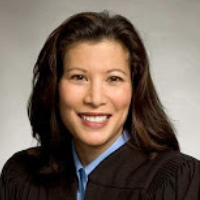Chief Justice: Add $1.2 Billion to Brown’s Court Budget to Avoid Closures, Layoffs
 Chief Justice Tani G. Cantil-Sakauye
Chief Justice Tani G. Cantil-Sakauye
Funding for the courts in Governor Jerry Brown’s proposed 2014-15 budget treads water with a small increase after $1 billion in cuts over the past six years. But California Supreme Court Chief Justice Tani G. Cantil-Sakauye says justice in the state is drowning.
Questioning California’s commitment to “a fundamental right in a functioning democracy,” Cantil-Sakauye laid out her own plan (pdf) for the state that would increase court funding $1.2 billion over three years. By her calculation, it would take an additional $266 million the first year just to “tread water.” The governor proposed less than half that, $105 million, but the chief justice thinks $612 million is a more realistic number.
Brown’s proposal would increase the court budget from around $3.1 billion to $3.27 billion. Most of that would go to the state's 58 trial courts, which would receive $2.5 billion. The budget would cement in place an administration effort to shift funding of the courts to the centralized Judicial Council by effectively eliminating local trial court reserves. Department of Finance Director Michael Cohen said the move would eliminate “great disparity” between the courts.
The decline in the judicial budget has resulted in closure of 51 courthouses and 205 courtrooms since 2010, according to the courts. Thirty courts operate with reduced public service hours and 37 courts have reduced self-help or family law facilitator services. At least 22 have reduced court interpreter services in civil cases.
Specialty courts dealing with drugs, the homeless, mental health, youth and domestic violence have been hacked at venues throughout the state. Around two dozen “critically needed” courthouse construction projects have been put on hold. Twenty-six courts have reduced security.
The court system has problems that go beyond the shortfall in funding from the state. It has been wracked for years by an internal struggle between trial court lawyers and the centralized judicial bureaucracy, as well as between the individual courts, over policy, governance and distribution of funds. All of this was exacerbated by the collapse of a $1 billion computer project in 2012 that was meant to unify the myriad judicial case management systems across the state.
The state cut bait after spending $500 million over a 10-year period and only a few counties have implemented aspects of it. The California Court Case Management System (CCMS) would have replaced 70 different systems already in place—many of which cannot talk to each—and result in a single case management system for all 58 Superior Courts.
Modernizing court technology was one of four goals in Cantil-Sakauye’s budget plan. She said a strategic plan for judicial branch technology will be presented in May. She also wants to fill the 50 trial court judge positions the Legislature authorized but did not fund in 2007, close the trial court funding gap, and expand physical, online and equal access to the courts.
Unmentioned among Cantil-Sakauye’s goals was one high up on Governor Brown’s list: reforming pensions. “There are some employees in the court system that still pay nothing into their pensions,” Finance Director Cohen said. “We need to move toward employees paying into roughly half the cost of their pensions.”
Courthouse News Service said it was unclear whether the mandate to have all trial court employees contribute to the pension included the top 30 administrators in the Administrative Office of the Court. They enjoy a “top-loaded pension perk where the taxpayers contributed 22 percent on top of salary to the administrators' pension accounts without any matching contribution from the individual administrator.”
–Ken Broder
To Learn More:
Chief Justice: Courts Need More Money Just to Maintain Status Quo (by Kathy Robertson, Sacramento Business Journal)
Brown Adds $100 Million to Court Budget (by Maria Dinzeo, Courthouse News Service)
A Three-Year Blueprint for a Fully Functioning Judicial Branch (California Courts) (pdf)
- Top Stories
- Controversies
- Where is the Money Going?
- California and the Nation
- Appointments and Resignations
- Unusual News
- Latest News
- California Forbids U.S. Immigration Agents from Pretending to be Police
- California Lawmakers Urged to Strip “Self-Dealing” Tax Board of Its Duties
- Big Oil’s Grip on California
- Santa Cruz Police See Homeland Security Betrayal in Use of Gang Roundup as Cover for Immigration Raid
- Oil Companies Face Deadline to Stop Polluting California Groundwater





